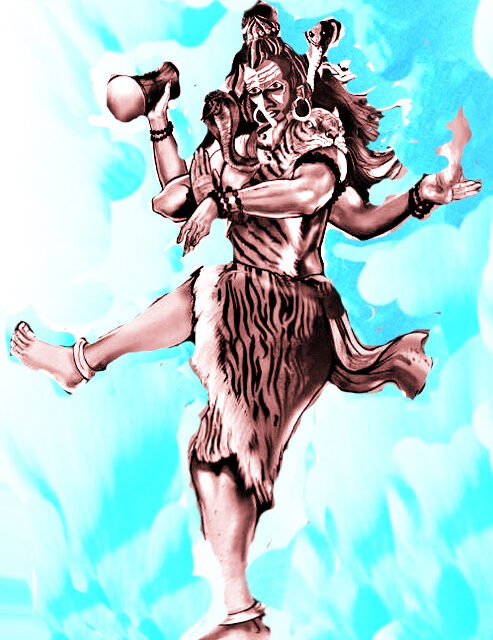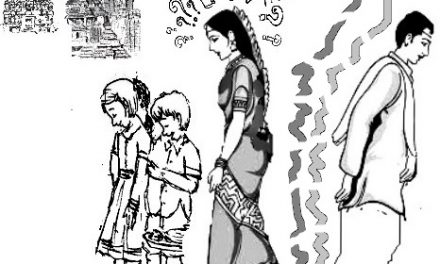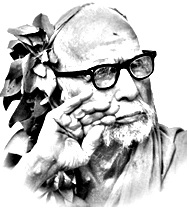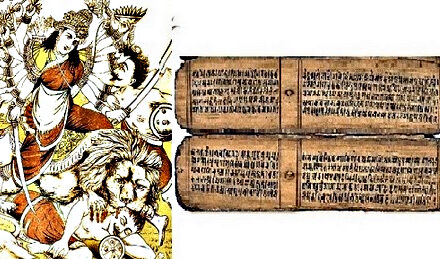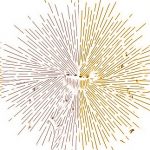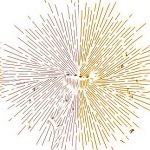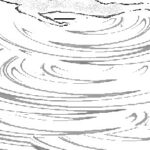Daksha Yagna
What the Universe gained ?
-Santhipriya-
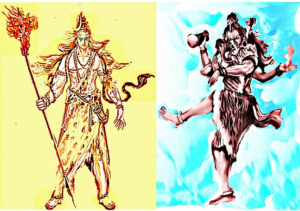
The highlight of the Navratri celebration is the worship of Sakti swaroopas. Though the Navaratri celebration is over, some forms of Goddesses Sakthi is continued to be worshiped round the year through the Yanthras energized with mantras of those Sakthi deities for many reasons such as to derive prosperity, wisdom, peace in family, settle disputes, gain occult power, gain yogic and tantric powers and to use as talisman. The Yanthras are traditionally consecrated and energized by a priest with mantras which are closely associated to the specific deity. One of the prime Sakthi worshiped amongst them is Goddess Parvathi an incarnate of Adi Parasakthi whose divine drama brought several benefits to the universe.
Shakti Pooja or worship of Shakti occupies very significant position in the spiritual world. Though various opinions have been aired on the origin of the cult, it is a universally accepted that Shakti worship constitutes a very important aspect of our religion specially after the drama of Daksha Yagna. From ancient scriptures as well as Tantra Shastra it is clearly evident that from 3rd century onwards Shakti worship has grown into prominence in various parts of the country. The Tantra Shastra emerged only after the divines emerged in the Daksha Yagna because the deities specific to the tantra emerged only in Daksha Yagna.
Various forms of Sakthi Swaroopas are creations from Goddess Adi Parasakthi in her manifestation as Goddess Parvathi, consort of Lord Shiva. There is no denial to the fact that Adi Parasakthi took the form of Goddess Parvathi and then only the other Sakthi manifestation in various forms emerged. Therefore one need to know the origin and history of Adi Parasakthi and how several female goddesses and divines in various forms were created by her through the epic Daksha Yagna divine drama for the welfare of mankind.
When cosmic was created, Goddess Adi Parasakthi intended to stage a divine drama and took the form of Goddess Parvathi, which led to series of events, emergence of worship places and manifestation of divines which not only benefited mankind in the Universe but also those engaged in occult, yogic and tantric practices for various purposes. Unless Goddess Adi Parasakthi had manifested as Sati and caused self-inflicted death, the spiritual world in Hinduism would have not seen eleven Siva Peedas, 51 Sakthi Peedas, eleven Vishnu Peedas (Thirunangur Divya Desam temples), Lord Veerabhadra, Goddess Bhadrakali, Maha Vida Devis, Mohinis and Yoginis from Maha Vidya Devis, Lord Kala Bhairava, through him Astanga Bhairavas, 64 Yoginis by Astanga Bhairavas in courtship with Astra Matrikas, besides Lord Dakshinamurthi, the greatest Guru in the universe and finally the 51 syllables of Sanskrit. Thus the divine play enacted intentionally by Adi Parasakthi in her manifestation as Sati remains important milestone in the world of spirituality in Hinduism. The huge fleet of Mohini and Yoginis thus created together with Maha Vidya Devis, possessed enormous tantric and magical powers to aid and assist Parameswari in her crusade against demonic and asura forces at various stages. In short the epic Daksha Yagya play was enacted by Adi Parasakthi only.
Who is Adi Parasakthi?
Who is Adi Parasakthi who reportedly created the cosmic and how did she take the manifestation as Sati is based on web of stories interlinked with each other. The puranic texts are clearly divided over who created the universe whether it was Adi Parasakthi or the one named Parabrahman?
The puranic texts agree that the one who created the universe pervade everywhere, created Trimurtis and other deities, moving and non-moving creatures, possessed active energy to create and destroy any and everything created, and enjoined eternally limitless power beyond the Universe.
The Sakthas who worship female form of Sakthi, consider Goddess Adi Parasakthi to be the Supreme being with or without form (nirguna and saguna), the one from which the universe appeared, is eternal truth and knowledge, has neither beginning nor end, manifested, unmanifested, all-pervading, omnipresent and transcendent divinity. Skanda Purana and Markandeya Purana talks about Goddess Parvathi as divine mother of all creation and truest saguna form of Adi Parasakti. Nirguna means without form and invisible to our eyes while Saguna refers to some kind of visible form to our eyes.
Non Sakthas however believe that it was Parabrahman or Paramathma who created the cosmic possessed the attributes mentioned to Adi Parasakthi. The Taittiriya Upanishad, which is a Vedic era Sanskrit text of Yajurveda, describes ‘Parabrahman as the one from whom all the creatures were born, being born by which they sustain, and into which they merge back’. The simple meaning of it is that ‘Parabrahman creates, sustains, and destroys the Universe by himself. Parabrahman inhabits in each and every object of the universe, pervades the universe and control the universe by allotting duties due to each object created’.
Katha Upanishad says ‘Paramathma is the same everywhere, in every world, on every level throughout the entire Cosmos. Until you recognize this you will continue to be reborn. Paramathma remains the same – in past, present and future. It is the same in the heart of an ant or an elephant, in every living being. It is the cause of everything’.
The general consensus amongst the puranic texts such as Devi Bhagavata Purana, differs slightly to say that ‘Adi Parasakthi is embodiment of half masculine and half feminine in nirguna form, all pervading and eternal. In order to create the universe, in her Nirguna (without form) form, Adi Parasakthi first created Lord Shiva and remained silent for many thousand years for specific reason’.
As per the Devi Bhagavata Purana, after manifesting, Lord Shiva sat on tapas and meditated on Adi Parasakthi for thousands of years, chanting a Beeja mantra called ‘Hreem’. Pleased with his tapas, a female emerged out from the left side of his body (Lord Shiva) who was Adi Parasakthi herself. Thus even Lord Shiva was unaware when manifested that his masculine energy had been embodied with the active dynamic feminine energies of Adi Parasakthi, identified with Goddess Parvathi.
Shiva Purana says ‘Adi Parasakthi incarnated in materialistic form as Param Prakriti from the left half of Lord Shiva i.e. Parabrahman during the beginning of the Universe. Once when both appeared, their union gave birth to the universe in the form of a cosmic egg which manifested as the universe. Once the Trimurti were created, Adi Parasakthi told them ‘I am Adi Parasakthi, the owner of this universe, absolute reality, dynamic in feminine form and static in masculine form. All three of you are partial expansions of mine, and I created you to govern the universe under my jurisdiction. While you three are the masculine form of absolute reality, I am the sole feminine form of that reality. I am beyond form, beyond everything, and embodied with eternally limitless powers’.
The sacred text of Devi Gita, which in the last nine chapters (31-40) of the seventh kanda of Devi-Bhagavata Purana, show dialogue between Goddess Parvati and her father Himavat, the King of Mount Himalayas. As per Devi Gita which is considered to be the Veda to Sakthas, Adi Parasakthi mother of the Universe who reside in Manidweepa (Sri Chakra) above all the other Logas revealed about herself to the Himalayan King thus ‘it was me who created the universe, me a divine, eternal truth and knowledge, has neither beginning nor end, manifested, un-manifested and transcendent divinity’. To convince him she displayed her true form where in Satya Loga, the first in the four yugas was seen on her forehead, universe in her hair, sun & moon as her eyes, her ears as four directions, vedas as her words, death, affection and emotion as her teeth and her smile as Maya’. This story also finds mention in Brahmanda Purana and Kena Upanishad two oldest texts in Hinduism. This is the brief background on Goddess Adi Parasakthi who later transformed herself as Goddess Parvathi to enact the drama in Daksha Yagna and subsequent benefits to the universe.
Adi Parasakthi became Sati
Now read the story of how Goddess Adi Parasakthi became Sati, daughter of King Daksha. Several thousand years after the cosmic was born, Daksha was born as one of the mind sons of Lord Brahma and became a King in the universe. When the childless couple desired to have a daughter for them, Lord Brahma, advised them to meditate upon the Goddess Adi Parasakthi to beget a daughter. Behind the scene, the said advice was given to Lord Brahma by none other than Adi Parasakthi herself in her nirguna form, who intended to enact certain divine play for certain reasons which was not revealed to Lord Brahma.
King Daksha and his wife meditated upon Goddess Adi Parasakthi who had by then transformed herself as Goddess Parvathi, consort of Lord Shiva. Therefore responding to the tapas of King Daksha, Goddess Parvathi though was saguna form of Adi Parasakthi, appeared before him in her original form- Goddess Adi Parasakthi. King Daksha requested that she be born to him as a daughter and she acceded to his plea, granted the boon and took birth as their daughter in the name of Sati because this is what was intended by Adi Parasakthi for the benefit of mankind. Goddess Parvathi in the form of Sati married Lord Shiva even as King Daksha did not like it.
Who is Sati and Dakshayani?
Lot of confusion may come while going through the texts in Puranas, especially while narrating the story of Daksha Yagna on the manifestation of Adi Parasakthi as Sati an or as Dakshayani. However it may be remembered that it was Adi Parasakthi who transformed herself as Goddess Parvathi in different manifestations and took birth as Sati to King Daksha the son of Lord Brahma, at the bidding of Lord Brahma. After her committal of suicide in the Yagna performed by King Daksha, she gets re-born to King Himalayan, the King of Himalayas and was then known as Dakshayani. After sometime she turns into Goddess Parvathi again and in all incarnations, she married only Lord Shiva because basically all were one and the same Goddess Parvathi originally in the form of Adi Parasakthi which was the embodiment of Shiva Sakthi.
Manifestation of Dasa Maha Vidya Devis
Once Adi Parasakthi transformed herself as Goddess Parvathi in the form of Sati, then began the divine play of Adi Parasakthi. The relation between Lord Shiva and King Daksha strained. King Daksha began to ignore Lord Shiva, though he was his son in law and in one of the most important Yagna performed by him, he deliberately did not invite Lord Shiva because King Daksha felt crazy that he had the blessings of both his father Lord Brahma and Goddess Adi Parasakthi who had born to him as his daughter and therefore he was superior. Although Lord Shiva was not invited to the sacrificial Yagna performed by him, Goddess Adi Parasakthi in the form of Dakshayani wanted to go and participate in that important sacrificial event to enact a drama which was not known to anyone. When Lord Shiva resisted her request and insisted her not to go, angry Sati, first took the form of Goddess Kali, and appeared in the form of ten ferocious female goddess to terrorize him from all directions due to which he had to agree to her request to go and attend the Yagna. Those ferocious ten incarnations of Goddess Kali became the Dasa Maha Vidya deities possessed with magical and tantric powers and became important divines in the higher spiritual world of Sadhanathviks, others engaged in tantric and mantric practices and to the world of occult practices. Those ten forms of Goddess Kali were called Dasa Maha Vidya devis were related to spiritual knowledge and wisdom. Dasa means ten and Vidya means knowledge. The aspects and attributes of those ten goddesses were in all forms – from motherhood to anger. The emergence of Dasa Maha Vidya Devis opened up a new chapter in the path of worship called Sakti worship also called as Saktha worship which is based on the principle that the female divines enjoined supreme divine power.
Adherents of worshiping the Sakthi (feminine divines) prefer to wear red colored dress and smear vermillion on their forehead. According to them, ‘Sakthi is absolute divine who pervade in the universe creating, protecting and caressing her own creations’. The development of the Maha Vidya worship-Goddesses of wisdom- became an important turning point in the history of bakthi moment in Shaktism as the then period was dominated by the vedas backed male divine worship. It was a new theistic movement in which the Supreme Being was envisioned as female. The Maha Vidya Devis only represent the various attributes of the Supreme Goddess like time, space, entropy, detached passivity, and force of action, the power to stop movement, sound force, and the power of the arts, riches, beauty and desire etc.
Some amongst those ten deities are worshiped by those who desire to get supernatural, magical, occult and tantric powers by chant of mantra and performing pooja to specific Yanthras. Tantra involve esoteric rituals and specialized knowledge which are derived from various Tantric scriptures and teacher traditions. Tantrism is a tradition of supernatural ritual found within many branches of Hinduism, Jainism, Buddhism, and to a lesser extent Daoism which is Chinese origin. They require the active supervision and guidance of qualified teachers and the use of mind and body for the attainment of certain spiritual and material aims. Hence lot of secrecy is associated with it. Certain forms of tantra aim to use the positive energies of the mind and body while some rely upon the negative energies to achieve these ends. If they offer worship to those ten Devis in the manner stipulated by observing certain norms and chanting the slokas in the most appropriate manner, they would certainly achieve the power what they desire. A very interesting aspect in the worship of the Maha Vidya Devis by the tantric worshipers have been the use of technique called Pancha Marga which is a faster way to attain siddhis or magical powers that the goddess grants, compared to the traditional forms of worship. The Pancha Marga way of worship employ traditionally forbidden elements such as liquor, meat, fish, meat, fermented grains and ritual sex while the normal Sadhaviks perform the worship in the most traditional manner after taking initiation from a learned Guru.
However if the rituals associated to the worship of Maha Vidya Devis are performed on their own, without taking diksha or initiation from a guru, the consequences would be disastrous and endanger their life because some of the goddesses in them are very ferocious in nature called Ugraha Devis. Therefore it would be beneficial that those who want to worship the deities should take initiation from a well versed Guru, learn the rituals properly and then only commence the worship. The worship involves observance of prescribed rites and rituals. Therefore, one should not commence the worship merely reading books superficially without the help of a proper guru. It would be better to go to temples and worship those goddesses than to worship them at home. The ten Maha Vidya Devis are Kali, Tara, Maha Tripurasundari, Bhuvaneshwari, Bhairavi, Chinnamastha, Dhooma Devi, Bhagalamuki, Mathangi and Kamalatmika. The story and attributes of those ten goddesses would be explained separately.
Manifestation of Nava Durgas
There is little confusion on the manifestation of Navadurga in Daksha Yagya. Goddess Nava-Durga are worshiped during nine days in Navaratri. Who are those Navadurgas? Two schools of thought throw different information. One say that during the destruction of Daksha Yagna, nine Durga forms called Navadurga came out from the body of Sati and went on destroying the Yagna along with other forces of Lord Shiva. Similarly the ten forms of Devis called Maha Vidya too came out of Sati only, but through Goddess Kali who came out of the body of Sati to terrorize Lord Shiva to accede to her request to attend the Yagna. But few suggest that the Nava Durgas when came out of Goddess Parvathi via Sati, they transformed into Maha Vidya Devis.
Though both groups of Devis -Nava Durgas and Ten Maha Vidya Devis- manifested during Daksha Yagna drama, they were different forms of same Goddess Parvathi in her incarnation as Sati. Goddesses Navadurga nine in number, are benign in nature and is the symbol of power. They are worshiped in nine different forms and is therefore termed Nava Durga. Each goddess has a different form and a special significance during Navaratri periods while Maha Vidya Devis due to their fierce nature are worshiped more by the Tantric. The names of Nava Durgas were Shailputri, the absolute form of Adi Parasakthi, Brahmacharini, who signified love, loyalty, wisdom, and knowledge of Adi Parasakthi, Chandraghanta who signified spiritual and internal power of Adi Parasakthi, Kushmanda signifying the energy of Adi Parasakthi, Skandamata signifying the powers to give salvation, prosperity, and treasures, Kathayini, signifying the warrior aspects of Adi Parasakthi, Kaalratri signifying the power of destroying ignorance, Mahagauri signifying the aspects of forgiving the sinners and purifying them and Siddhidhatri signifying the eight supernatural powers or the siddhis called Anima, Mahima, Garima, Laghima, Prapti, Prakambya, Ishitva and Vashitva.
In Shiva Maha Purana written by J.L. Shastri it is stated that Sage Narada was told by Lord Brahma that ‘nine Durgas namely Kali, Kathyayani, Isani Chamunda, Mundamardini Bhadrakali, Bhadra, Tvarita and Vaishnavi along with Mahakali and the goblins went and destroyed the Daksha Yagna. The host of 64 Yoginis present there too set out angrily to destroy Daksha’s sacrifice under the command of those nine Durgas’. It is not clear which version is correct because none of the puranic texts precisely indicate how the Nava Durgas manifested, though the Daksha Yagya drama has reference on Nava Durgas. But one thing is certain that during Daksha Yagna nine forms of Goddess Durgas have emerged, though their names are varying in various texts.
Emergence of Yoginis and Mohinis
Many celestial maidens called Yoginis and Mohinis came out of the divine energies of the ten Maha Vidya Devis and became warriors in the army of Goddess Adi Parasakthi and took part when Parameswari in different forms annihilated the asuras and demonic forces. Originally eight great female Goddesses called Matrikas emerged from Adi Parasakthi when she was Sati. Each of those eight Matrikas along with Astra Bhairavas generated eight divine energies from each of them called Yoginis thus totalling to 64 Yoginis. The Yoginis took part in the annihilation of forces of King Daksha in the Daksha Yagya drama. During Daksha Yagna several Yoginis too came out of ten Maha Vidya Devis. Therefore the Yoginis or Mohinis too are to be seen as emanations from Adi Parasakthi only.
As per Shiva Purana, ‘the group of 64 Yoginis together with nine Durgas took part in the battle along with Lord Veerabhadra against King Daksha. The nine Durgas along with Goddess Bhadrakali another emanation from the hair lock of Lord Shiva went ahead with the destruction of Daksha.
Though more Yoginis and Mohinis with tantric and magical powers too manifested at various stages from the divine energies of Goddess Adi Parasakthi in her various manifestation, only the 64 Yoginis emerged from the Astra Matrikas, most of them ugraha (ferocious and angry) devathas have been enshrined in some tantric temples dedicated to them. The tantric and occult power seekers worship them to gain tantric, occult and magical powers. Those who had gained those powers use them for good causes while some are also misused for enacting evil deeds and acts. The sixty-four Yoginis are powerful assets in providing growth and development of the gross, subtle, and causal planes within each of us. This is the very foundation needed for awakening of soul on the highest level called wisdom.
Those 64 powerful Yoginis later became tantric Yoginis embodied with powers to fulfil ones desires, drive away negativity and fear, prevent misfortunes, give knowledge, peace, all-around prosperity, good progeny, and auspiciousness of all kinds provided they were worshiped chanting specific Beeja mantras with proper ritual and sadhanas meant for each of them. However one must remain cautious and go in for performing such sadhanas only after they take initiation from learned Gurus. The Yoginis were of two types. One group is identified with mantra syllables, the second preferred to remain above cemeteries and cremation grounds and appear to Sadhak on invoking them by proper esoteric rituals, lest they would also harm them if improper rituals are performed to appease them.
Worship of the divine female has always been linked to Tantra practices and emerged Pre-historically. One unique characteristic of the tantric devathas is to reside in the roofless temples situated in remote places, difficult of access and constructed in circular or rectangular in shape temples. The reason is not known. Hence typically, the Yoginis were placed around the circumference of the open air temples, each looking in toward the center where their master deity- mostly Lord Bhairava- remained seated. They act on his orders.
The Yoginis serve as attendants of Lord Kshetrabala who is none but chief of Bhairavas. Some of them appear in the form of half female and half animals or vice versa and disseminate esoteric tantric knowledge. Some of them prefer to have animals and even birds as their carrier vehicle. They possess extraordinary magical and other abnormal powers and abilities beyond normal experience. As per Skanda Purana, ‘Lord Bhairava is the Lord of goblins, he is the form of Lord Shiva and he destroys the strength of the mighty rogues and the wicked and the remover of all sins. Some of the Yoginis remained as attendants to Lord Shiva and Goddess Parvathi too. References about the 64 Yoginis and their powers can be found in the ancient scriptures like Brahmanda Purana, Agni Purana, Skanda Purana, Kalika Purana, Chandi Purana etc.
Kali Yogini Tantra text revealed that goddess Maha Kali told the assembled Deva Loga celestial, Rishis and others on 64 Yoginis thus ‘ Each of my sixty-four forms (Yoginis) are attendants of mine because I am in them and they are in me. My sixty-four forms have the power to manifest from the body of the other Yoginis and each of them have the power of regeneration too because each of them are me alone in their forms.
There are very important temples meant for the 64 Yoginis where they were worshiped by tantric and sadanaviks. They are Ranipur-Jharial 64 Yogini Temple (Located in the Balangir district of Odisha), Khajuraho 64 Yogini Temple, Bhairaghat 81 Yogini Temple (located in Jabalpur district of Madhya Pradesh), Mitaoli 64 Yogini Temple (the village of Mitauli, in the state of Madhya Pradesh), Hirapur 64 Yogini Temple (small village of Odisha) and Bodah Yogini Temple (few kilometers from Kulhar train station, Madhya Pradesh).
Manifestation of Lord Veerabhadra and Goddess Bhadrakali
Finally when Sati attended the Daksha Yagna and faced insult from her father, she destroyed the Yagna kund, and committed suicide in the same fire. Angered Lord Shiva plucked two dreadlocks from his hair and thrashed the ground with them. One of the dreadlocks transformed into Lord Veerabhadra, Shiva’s destructive and terrible incarnation and a fierce warrior with eight hands holding weapons and the second became Goddess Bhadrakali in violent and intense incarnation with 18 hands holding weapons of many types. Some mention that the Kali manifested from Goddess Sati and joined with Lord Veerabhadra to destroy the Yagna. The Yagna was destroyed, the forces of Daksha annihilated completely. Thereafter grief-stricken Lord Shiva carried the dead body of his wife over his shoulder and roamed around the universe. Lord Veerabhadra represent the warrior god who destroy ones ignorance and ego. He is worshiped to settle land disputes, freed of effects of black magic spells, and cure those mentally retarded. Though he is not worshiped as the principle deity in the temples of Lord Shiva, he is considered to be the important divine to be worshiped after offering worship to Lord Shiva. However in Karnataka and Telangana states, Lord Veerabhadra remains the family deity of many and worshiped with reverence. He has several separate temples in many regions. He has manifested in the form of Agni Veerabhadra, Agora Veerabhadra, Pavana Veerabhadra, Kalyana Veerabhadra, Uthanda Veerabhadra etc and worshiped in several temples.
Goddess Bhadrakali is the fearful and ferocious form of the mother goddess Durga, also known as the gentle Goddess Kali who is the auspicious power of time. Goddess Kali is the feminine form of time, whose muscular form is Kala which is darkness. Therefore Goddess Kali removes the darkness and give light in one’s time of life. Goddess Bhadrakali is one of the Supreme Deity mentioned in Devi Mahatmyam. One of the forms of Goddess Kali has been Goddess Bhadrakali as mentioned in Devi Mahatmyam. As per the texts of Vayu Purana and Mahabharata, she manifested during the Daksha Yagna. The Tantra Shastra text mentions that she rose from the north face of Lord Shiva. (What is meant in this is that Lord Shiva could see all directions in one go as he had invisible eyes in each direction and therefore in Daksha Yagna she manifested from the invisible face in the northern direction). Goddess Kali has many manifestations and in one of her manifestation she is even consort of Lord Shiva when he was in the form of Rudra. Similarly she was also considered to be the consort of Lord Veerabhadra in another manifestation. She reportedly has eight forms. She appeared in various metaphysical forms for the welfare of the Universe. She is considered to be the most important deity in the world of tantric.
One of the most important book in the tantra text has been the ‘Maha Nirvana Tantra’ in which Goddess Kali has been glorified by non-other than Lord Shiva himself. It is one of the most important Tantric texts. The text is in the form of dialog between Lord Siva and his consort Goddess Parvati where the Lord himself explains the theory and practice of Tantra and initiate various esoteric mantras to her. While glorifying Goddess Kali who is a manifestation of Goddess Adi Parasakthi, he told her ‘You as Kali is the supreme Yogini who moved by the mere desire of Parabrahman to create, protect, and destroy this world with all that moves and is motionless. The cosmic was created when you existed in the form of Mahakala called darkness which is beyond both speech and mind. As if to resume after dissolution, you created the cosmic from darkness by the mere desire of Parabrahman. Since you are also the primordial Mahakali, the absolute truth and original form of all, and called Adya Kali, you are also in the form of Tarini, Durga, Shodashi, Bhuvaneshvari, Dhumavati etc. You are ever eternal with no beginning and end, appear in multi forms by the power of Maya. You were also in the forms of Bhagalamuki, Bhairavi, and Chinnamastha. You are Annapoorna, Vagdevi, and Kamalalaya. You are embodiment of all the Shakti and of all the Devas. Since you are the creator, protector and destroyer, ever eternal, changeless, omnipresent, pure intelligence unattached to, yet existing in and enveloping all things moving and motionless as one ineffable, inconceivable both with form and formless, whatsoever fruit is attained by initiation in the Brahma Mantra, the same may be had by the worship of you. In other Tantras I have spoken of the different Mantras and Yantras, with the use of which you should be worshiped according to different forms to gain the fruits in life’. Further Lord Siva recited a hymn to Goddess Parvati, containing the hundred names of Kali, and said by worshiping Kali and repeating her hundred names, one will enjoy a happy life and becomes overflowed with the presence of the Devi, attain his desires, conquer his enemies, and enjoy good fortune. What more is needed for glorifying Mahakali also called Bhadrakali?
Mother Bhadrakali is a quite ancient mythological deity. The entire Indian tantra literature is full of prayers and hymns for mother. The Gadaparva of Mahabharata Padma Purana, Markandeya, Purana, Chandi Purana of Sarala Das, Vishnu Purana, Srimad Bhagabata Tantraprasanga of Sri Krishna and the second part of Harivamsa make vivid references to goddess Bhadrakali as all pervasive and eternal incarnation of Parambrahma.
Goddess Kali play an important role in the study and practice of Tantra Yoga. Although Parvati is often said to be the recipient of Shiva’s wisdom in the form of Tantras, and both Kali Devi and Parvathi Devi are one and the same, still it is in the incarnation of Goddess Kali she is dominating much of the Tantric iconography, texts, and rituals.
Emergence of Sakthi Peedas
When Lord Shiva performed the terrible Tandava Nritya, or Dance of Destruction he beat his drum which released ear deafening sound ‘Dum’, ‘Dum’. The gods, goddesses, saints, sages and the world trembled in fear. The mind sons of Lord Brahma, Sanath Kumars were sitting and meditating on Lord Shiva in the mount of Sathathrunga. Dispassionate and not interested in material things they began to think about the reason for existence of something called creation including their own, and several questions which sprang from their minds remained unanswered by Lord Brahma himself. Therefore at the suggestion of Lord Brahma himself, they sat on deep meditation for several hundred years meditating to get answers to their never ended queries. They were on such deeper meditation that when both Lord Shiva and Goddess Parvathi came before them, their meditation did not get disturbed because they were meditating for a guru who would clear their doubts. When the ear deafening terrible sound of Dum, Dum from the drum of Lord Shiva during his dance of destruction broke their meditation, they woke up from meditation and instantly worshiped him from a distance.
Soon at the request of the celestial and other divine forces Lord Vishnu using his Sudarshan Chakra cut the body of Goddess Parvathi lying over the shoulders of Lord Shiva into 51 body parts which fell on Earth as stars from sky fell on ground with a powerful spark. During the dance, Sati’s body came apart and the pieces fell at different places on earth, however according to another version, Shiva placed Sati’s body on his shoulder and ran about the world, crazed with grief when the body was cut by Lord Vishnu. Once entire body cut into pieces fell down from the shoulders of Lord Shiva, he cooled down. In those places where the body parts of Goddess Parvathi fell, Sakthi Peedas –temples for Goddess Adi Parasakthi- came up on their own or built. Lord Shiva sent Lord Bhairava in various forms to guard those Sakthi Peedas.
Those Sakthi Peedas are considered to be very powerful because her body parts embodied with all energies and powers of Adi Parasakthi including yogic and tantric powers fell and merged into the land there. Therefore Goddess Adi Parasakthi is believed to pervade alive in those places where the Sakthi Peedas have come up. Adi Parasakthi at each of the Sakthi Peedas is non other than Goddess Parvati or Goddess Durga.
The places where different organs/parts of Sati’s body and ornaments fell became sacred places and were called Peeda. At present there are 41 Shakti Peedas in India, four in Bangladesh, three in Nepal and one each in Pakistan, Sri Lanka and Tibet. There are traditionally 51 Shakti Peedas.
Manifestation of Astanga Bhairavas
Lord Kala Bhairava who manifested from Lord Shiva when asked to guard the Sakthi Peedas, he split his body and manifested as Astanga Bhairavas to stand guard to Sakthi Peedas. Lords Astanga Bhairavas married Goddesses Ashta Matrikas and all of them in dreadful forms created further 64 Bhairavas and 64 Yoginis. The huge fleet of Bhairavas, Mohini and Yoginis thus created together with Maha Vidya Devis, possessed tantric and magical powers to aid and assist Parameswari in her battles to annihilate asuras and demonic forces on various occasions and to help and guide the Sadhaviks engaged in tantric and occult practices to attain sadhanas and siddies. Thus they have became important deities in the world of occult practices.
Manifestation of Guru- Lord Dakshinamurthi
After Sati’s body parts fell on different places on earth, Lord Shiva cooled down. Immediately the Sanath Kumars went before him in the mount of Sathathrunga and pleaded that they be enlightened and their unending queries be answered, Lord Shiva assured them that he would himself appear to them as a Guru and enlighten them at a right time . This led to the manifestation of Lord Dakshinamurthi, an important Guru. After some time merciful Lord Shiva, who is the in dweller of all beings, as promised to Sanathkumaras, turned into a sixteen year old youth and sat under a Banyan tree. He was first identified by four of the elderly Sanakadi rishis as the perfect teacher to enlighten them. The concept of Dakshinamurthi mentioned in the Rig Veda was the transformation of Lord Rudra into the giver of wisdom. Lord Dakshinamurthi is believed to teach through ‘Para Vak’, which is a divine speech form not audible to worldly ears and resides in the silence. Ordinary expressions are not needed to grasp the teachings of Dakshinamurthi who explains the true meaning of Brahman naturally.
Emergence of Sanskrit Syllables
It is stated that the sound emanated by the drum -‘Dum Dum’- became 51 syllables of Sanskrit, and the temples erected on the places where the letters of the 51 Sanskrit letters fell like spark of star, were called Atshara (word) Shakti Peedas. Adi Beejatshara mantra contains all the 51 syllables of the Sanskrit text. Thousands of celestial forces and Rishis have gained severally in yogic and tantric siddies by performing penance in the Adi Beejatshara Shakti temples.
Emergence of Thirunangur Divya Desams and Siva Peedas
Similarly when Lord Shiva performed Dance of Destruction, his broad Jada hair fell on eleven places at Upaya Kaveri river bed areas. Instantly they turned into twelve Rudra forms of Lord Shiva and simultaneously danced in sync with main form of Lord Shiva. Immediately Lord Vishnu too took eleven forms, reached those places and embraced the twelve forms of angry Rudra forms of Lord Shiva and defused their anger. Thereafter all the eleven mirror forms of Rudra merged together and appeared in the form of a single Rudra, an incarnation of Lord Shiva. Those eleven sacred sites in and around the village Thirunangur, near Seerkazhi in Tamilnadu, later turned into eleven sacred sites for Lord Vishnu called Thirunangur Divya Desam (temples). Besides those eleven Lord Vishnu Peedas, eleven Thirunangur Lord Shiva Peedas (Temples) too came up on those eleven places where the mirror forms of Lord Shiva danced in the form of Rudra and cooled down by the embrace of Lord Vishnu.
Thus by the divine drama of Daksha Yagya, Adi Parasakthi ensured that several temples and important divines emerged for the benefit of the Universe.

